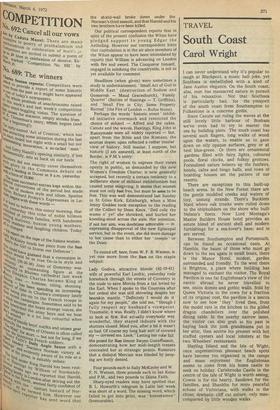TRAVEL
South Coast
Carol Wright
I can never understand why it's popular to laugh at Blackpool, a music hall joke, yet Southsea is embellished with a kind of Jane Austen elegance. On the South coast, alas, man has massacred nature in pursuit of his relaxation. Not that Southsea is particularly bad, for the ymajorit of the south coast from Southampton to Folkestone is a concrete girdle.
Since Canute sat ruling the waves at the still lovely little harbour of Bosham we've even had to try to master the sea by building piers. The south coast has several such fingers, long walks of wood upon the waters, to enable us to gaze down on oily opaque surfaces, grey or at best blue-green. Or there are ornamental gardens filled with fairy lights, coloured pools, floral clocks, and folksy grottoes. Formalised nature bolsers up the funfairs, hotels, cafes and bingo halls, and rows of boarding houses set the pattern of our resorts.
There are exceptions to this built-up beach arena. In the New Forest there are the gentle muddied creeks and waters of tiny, unsung strands. There's Bucklers Hard where oak trunks were rolled down to the shipbuilders on the shore who built Nelson's fleets. Now Lord Montagu's Master Builders House hotel provides an astute blend of ancient shell and modern furnishings for a sea-lover's base; arid in are served.
Between Southampton and Portsmouth, can be found an occasional oasis. At Harnble, the haunt of those who must go down to the sea again in small boats, there is the Manor Hotel, modest, garden surrounded and friendly. To the west there is Brighton, a place where building has managed to enchant the visitor. The Royal Pavilion is one fat Englishman's view of the exotic abroad he never travelled to see, onion domes and gothic walls. Sold by Queen Victoria to the town for a fraction of its original cost, the pavilion is a mecca now to see how ' they ' lived then, from the model rats in the kitchen to the gilded dragon chandeliers over the polished dining table. In the nearby narrow lanes, the visitor can also grab at his past in buying back the junk grandmama put in her attic, then soothe his present with hot stuffed oysters and local lobsters at the two Wheelers' restaurants.
Hayling Island and the Isle of Wight, once unpretentious pleasant beach spots have become too organised in the camps and mass enjoyment the Englishman seems to come from his home castle to seek on holiday. Carisbrooke Castle in the centre of the Isle of Wight is worth seeing, Cowes is for the hearty, Sandown for the families, and Shanklin for more peaceful echoes of Victoriana, with walks in the chine; dramatic cliff cut nature, only manconquered by little wooden walks.










































 Previous page
Previous page